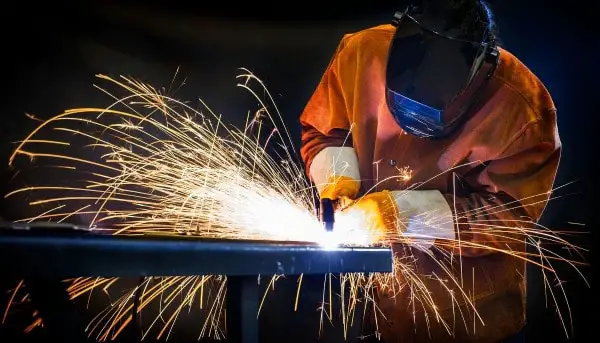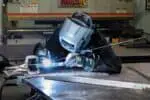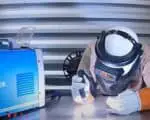Aluminum is a common welded metal due to its good features like lightweight, strength, and resilience. It has a melting temperature of about 1220 degrees Fahrenheit and is the finest heat and electricity conductor.
Also, this metal may be easily alloyed with other metals, making it extremely versatile, stronger and more durable.
Plasma cutting machines, on the other hand, have gone a long way since the late 1990s, and they now come with features such as cutting technology that allows them to quickly cut through any sort of conductive metal.
Aluminum is a conductive metal and, as such, can be easily cut with a plasma cutter if it is less than six inches thick. Plasma cutting aluminum is not only conceivable, but also very effective, as with any electrically conducting metal.
But before we get further into the topic, let us understand what this plasma cutting method is.
What is Plasma cutting and how does this method work?
Plasma cutting is a method of cutting steel, stainless steel, and aluminum with the help of a plasma torch.
In simpler terms, high-speed gas is pushed from a nozzle while an electrical arc burns the metal and compressed air blows away the molten metal.
The plasma cutting procedure is a type of thermal cutting. That is, instead of manually cutting the metal, it melts it with heat.
Plasma cutters operate with compressed air or other gases such as nitrogen, and plasma is formed by the ionisation of these gases.
Typically, the compressed gases come into contact with the electrode and ionise, resulting in increased pressure. As the pressure rises, a stream of plasma is directed towards the cutting tip.
The cutting point constricts the flow, resulting in a plasma stream. This is then applied to the workpiece. Because plasma is electrically conductive, the workpiece is grounded via the cutting table.
When the plasma arc comes into touch with the metal, its tremendous temperature melts it. At the same time, the molten metal is being blown away by the high-speed gases.
Why is Plasma cutting best suited to weld aluminum?
Plasma cutting aluminum has substantial benefits over laser cutting, notably in terms of thickness, since lasers can only cut metals up to around 25 mm thick, but plasma can cut through aluminum up to 160 mm thick.
Plasma is also more affordable than laser since it requires less equipment and has reduced operational expenses.
But when it comes to precision cutting, laser cutting is ideal. However, while it is true that laser is capable of cutting finer detail, the more accurate tolerance delivered by laser cutting is only really relevant for those projects that require extremely fine detail like the aerospace industry.
However, the cut quality provided by plasma is adequate for most applications and industries.
| Plasma cutting | Laser cutting | |
| Cutting range | Yes | |
| Equipment cost | Yes | |
| Precision | Yes | |
| Operation cost | Yes | |
| Level of difficulty | Yes |
Advantages of using Plasma cutting method
1.) Easy to use
These plasma cutters are lightweight and portable, allowing you to carry them wherever the work requires. Some brands are so small that they can be handled by a single individual.
2.) Quality Precision
To achieve a truly clean cut, an expert operator with a steady hand is required. Precision or exact cutting is one of the primary benefits of a plasma cutter, particularly when cutting varied shapes or angles using sheet metal.
3.) Greater Versatility
Plasma cutting may be done on a variety of metals. It cuts any conductive metal, such as steel, iron, copper, brass, aluminum, stainless steel, and other long-lasting materials, using an electric arc.
Plasma can also cut materials that are layered on top of each other at the fastest cutting speed. This cannot be replicated by techniques such as Oxyfuel.
4.) Quick Cuts
When comparing the cutting speed of a plasma cutter to that of other cutting instruments, the plasma cutter comes out on top since it saves time and is much easier to use than other cutting tools.
5.) Safety
This cutting procedure is safer than others since it employs gas that is not particularly combustible.
6.) Piercing velocity
When compared to Oxy Fuel, plasma truly shines in this area. Inside piercing is required for many cutting applications. When piercing 15 mm metal with Oxy Fuel, it must first be heated to around 1000 Celcius, which can take up to 30 seconds.
Because plasma does not require this stage, it may do the same piercing in less than two seconds. Less time means less money for the end user.
7.) Lower Cost
Plasma can cut things quicker and with less waste, and it has a low loss rate owing to on-the-job accidents. This reduces the cost to the end user, making it a more cost-effective operation than other cutting processes.
Now let us see the disadvantages of Plasma cutting-
1.) When compared to laser cutting, the Heat Affected Zone is larger.
2.) Quality is not as excellent with thinner sheets and plates as it is with laser cutting.
3.) Tolerances are not as tight as with laser cutting.
4.) It does not attain the same thickness as waterjet or flame cutting.
5.) Waterjet does not leave a Heat Affected Zone.
6.) Kerf width is greater than that of laser cutting.
Conclusion
Perfect welds may be produced by plasma cutting method and it also helps to prevent the deformation or paint damage that is usually common with flame cutters. Plasma cutters fuse aluminum workpieces together precisely and fast, resulting in clean and precise welds.








